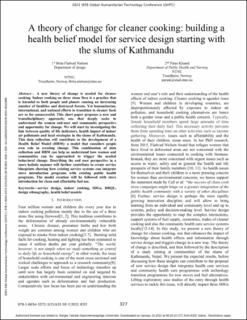| dc.contributor.author | Nielsen, Brita Fladvad | |
| dc.contributor.author | Khanal, Paras | |
| dc.date.accessioned | 2022-03-28T12:06:02Z | |
| dc.date.available | 2022-03-28T12:06:02Z | |
| dc.date.created | 2022-01-10T09:27:04Z | |
| dc.date.issued | 2021 | |
| dc.identifier.isbn | 978-1-6654-3372-3 | |
| dc.identifier.uri | https://hdl.handle.net/11250/2988021 | |
| dc.description.abstract | A new theory of change is needed for cleaner cooking. Indoor cooking on three stone fires is a practice that is harmful to both people and planet: causing an increasing number of fatalities and destroyed forests. Yet humanitarian, international, and national efforts to transition to cleaner fuels are so far unsuccessful. This short paper proposes a new and transdisciplinary approach; one that deeply seeks to understand the women end-user and community perspective and opportunity for change. We will start by investigating the link between quality of life indicators, health impact of indoor air pollutants and local strategies in the slums of Kathmandu. This data collection will contribute to the development of a Health Belief Model (HBM): a model that considers people own role in creating change. This combination of data collection and HBM can help us understand how women and communities can be approached to trigger the needed behavioral change. Describing the end user perspective in a more holistic manner will further contribute to create service blueprints showing how existing service systems can integrate stove introduction programs with existing public health programs. The model creation will be followed with stove introduction for clean and affordable fuel use. | en_US |
| dc.language.iso | eng | en_US |
| dc.publisher | Institute of Electrical and Electronics Engineers (IEEE) | en_US |
| dc.relation.ispartof | Proceedings of the 2021 IEEE Global Humanitarian Technology Conference (GHTC) | |
| dc.title | A theory of change for cleaner cooking: building a health belief model for service design starting with the slums of Kathmandu | en_US |
| dc.type | Chapter | en_US |
| dc.description.version | acceptedVersion | en_US |
| dc.rights.holder | © IEEE. Personal use of this material is permitted. Permission from IEEE must be obtained for all other uses, in any current or future media, including reprinting/republishing this material for advertising or promotional purposes, creating new collective works, for resale or redistribution to servers or lists, or reuse of any copyrighted component of this work in other works. | en_US |
| dc.source.pagenumber | 327-330 | en_US |
| dc.identifier.doi | 10.1109/GHTC53159.2021.9612489 | |
| dc.identifier.cristin | 1977177 | |
| cristin.ispublished | true | |
| cristin.fulltext | original | |
| cristin.qualitycode | 1 | |
